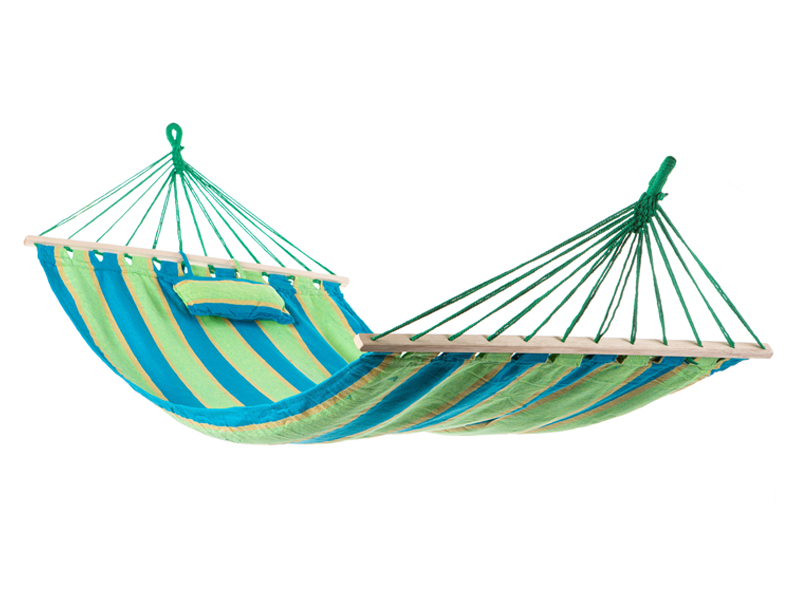It’s summer, and lying on your hammock under the hot summer sun is a great way to relax.
A hammock will still be handy for hiking or having fun in the garden with your family.
Do you want to buy a hammock? Are you still indecisive about which material to buy? We are here to help.
Different materials, such as cotton, polyester, nylon, parachute silk, canvas, etc., are used in making hammocks. But today, we will look at the hammock materials, emphasizing cotton, polyester, and nylon, as they are the most commonly used worldwide. One of the most important aspects of a hammock is the material it is made from. Different materials can provide different levels of comfort, durability, and weather resistance. In this post, we will explore the best materials for hammocks and their pros and cons.

Cotton hammocks
Cotton hammocks have so far been the cheapest of all. This fact also explains why the vast majority use them. Cotton is used in both rope and fabric hammocks.
Aside from its price, cotton fabric is also popular because of its comfort. Its softness and stretchiness make it wrap itself around your body to give you that comfortable feel.
Cotton is your best bet if you plan to sleep often in your hammock. It is best when you need an indoor hammock.
Pros:
1. Comfortability. If you want a hammock for relaxation, go for organic cotton hammocks.
2. Portability. Cotton hammocks are very portable. They are easy to carry about as a result of their lightweight. Their portability also makes them ideal for backpacking.
3. Cotton hammocks are tear-resistant, which increases their durability.
4. It is simple to clean. It is easy to wash by hand or machine, although cleaning only with a machine is advisable.
5. It is appealing to the eyes. Cotton hammocks come in several colors that appeal to the eyes and give those summer vibes.
Cons.
1. Cotton hammocks absorb moisture.
This makes them vulnerable to mold and also rot. So if you don’t take proper care of your cotton hammock, it will deteriorate quickly. In that case, you would have to get a new one.
2. They are not UV resistant. This means that with increased exposure to the sun, those beautiful colors that attract you to that hammock may fade away quickly.
Care of cotton hammocks
- Avoid exposing it to the elements – sun, rain, or even a drizzle. Cotton hammocks do poorly with all these, so do not expose them.
No, this does not mean you can not enjoy your hammock outside your house.
We are only saying that once you are done relaxing on it outside the house, take it inside to increase its lifespan.
2. You should wash the cotton hammock regularly. It is okay to clean it once in the season or maybe twice if you have stained it.
A cotton hammock that is well taken care of can last 20 years or even more.
Now that you know about cotton hammocks, let us talk about the second one.

Polyester hammocks
Polyester hammocks are another trendy material for hammocks. They are made of synthetic materials. The polyester hammocks are more durable than cotton because of their resistance to both water and UV light, though they are not as soft and comfortable.
They are a bit more expensive than cotton. Polyester hammocks have more advantages than disadvantages, which makes them more desirable to people.
Pros:
1. weather resistant. It is ideal for use in the garden because it does not absorb water and is not affected by UV light
It saves you the stress of taking it into the house from time to time, as in the case of cotton hammocks. This also means that you will never ever find mold on your hammocks.
2. Polyester hammocks also dry quickly when wet.
You do not even have to wait for it to dry; grab a piece of cotton towel and wipe it down, and it is ready for use.
3. It is also much more durable than cotton.
Cons:
1. It is not as comfortable as cotton.
2. Although it does not absorb water, it still absorbs oil, including the one on your skin.
So, lying bare-bodied on polyester hammocks can cause that part of your skin to dry out.
Care of a polyester hammock.
1. Wash it to clean it. Cleaning polyester hammocks is relatively easy. All you need is water, a bristle brush, and a mild detergent.
Here is how you do it.
I. Fill your bathtub halfway with water, add your mild detergent, and soak your polyester hammock in it.
II. After a few minutes, scrub your hammock with the bristle brush to remove stains.
III. Drain out the water in the bathtub and rinse at least twice in clean water.
IV. Spread your polyester hammock in the sun or shade to dry.

Nylon hammocks
Nylon hammocks are stronger than polyester but not as widely used as polyester and cotton. This is because nylon is more expensive to produce than polyester or cotton. It usually used as camping hammock.
Nylon hammocks are pretty soft. They are like plastic bags and have soothing relief.
Pros
1. It is more robust and more durable to use. You can strengthen it by weaving additional fibers to the original threads to avoid rips or tears. This is known as ripstop.
2. It absorbs water better than polyester and is best used as a camping hammock.
3. To make it more weather resistant, it usually has an additional coating.
4. Due to its stretchability, nylon hammocks can hold more weight than polyester. Typically, it can hold 150-200kgs of swinging weight.
5. Nylon hammocks will also enhance breathability. Therefore, it is suitable for the summer season
Cons
1. It can absorb more water than polyester. Thus, it takes a longer time for it to dry out.
2. It is relatively more expensive than polyester and cotton.
Care of a nylon hammock
1. It is preferable to detach any rope or carabiners before washing. Wash them separately.
2. Wash gently by using a mild detergent. Avoid scrubbing it with any hard object, such as a brush. Doing so can tamper with the nylon.
3. Remember to use cold water when washing.
4 Avoid putting the hammock in a dryer. It dries quickly, and a simple outdoor drying is enough.
Note that other than cotton, polyester, or nylon:
• Parachute silk is also used to produce hammocks. It is nylon made into thin threads and then woven together. It’s durable hammock.
It dries quickly when wet and is mainly used by travelers and hikers because of its portability.
• Organic cotton can also be used. This is handpicked cotton. It is much more comfortable than machine-picked. It is also best for our skin as it is not processed with chemicals.
• Canvas can also be used. This is cotton interwoven with PVC. It is more durable than regular cotton, and it is UV resistant. However, it absorbs more water than regular cotton.
Conclusion
Choosing a material for your hammock depends on your choices. There is no formula for it.
If you value comfort over durability, you might go for cotton and vice versa.
As you have gone through the article, I am sure you now have adequate knowledge to help you choose a hammock you will relax in this summer.
Remember, Jaunty Leisure is always ready to deliver the best hammocks!

